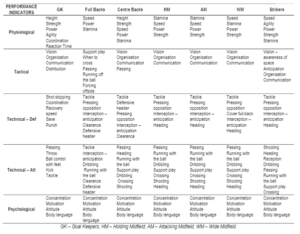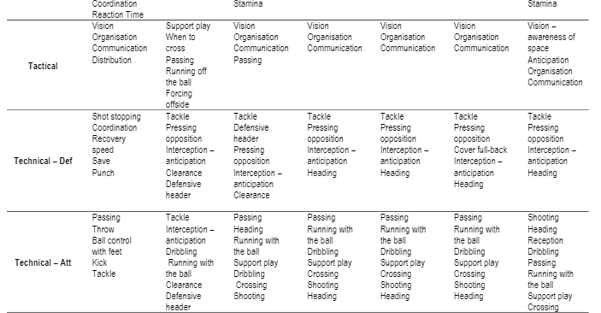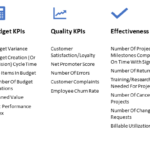ABSTRACT
Hughes M, Caudrelier T, James N, Redwood-Brown A, Donnelly I, Kirkbride A, Duschesne C. Moneyball
and soccer – an analysis of the key performance indicators of elite male soccer players by position. J. Hum.
Sport Exerc. Vol. 7, No. 2, pp. 402–412, 2012. In most sports, it is found that the important performance
indicators (PI’s) vary from coach to coach. Therefore, if sets of PI’s can be identified and clear operational
definitions defined, there is significant scope/benefit for consultancy and research, particularly in
commercially orientated sports such as soccer. The aim of this study was to use the unique opportunity of a
large number of performance analysts coming together to discuss this problem and its application to
soccer, and define sets of performance indicators for each position in soccer. In the early spring of 2011,
staff from 9 universities, from all over Europe, brought 51 level 3 Sports Science students to Hungary for an
Intensive Programme in Performance Analysis of Sport (IPPAS). The 15 staff, all experts in PA, had a total
of over 200 years of experience of PA between them. The most experienced ‘experts’ (N=5) acted as
mentors, introducing the area, defining the aims and managing the groups. The rest (N=10) and the 51
students were distributed evenly as possible across 7 groups, in which their aim was to define the key PI’s
for one of the positions in soccer. The positions used were:– Goalkeepers; Full Backs; Centre Backs;
Holding Midfield; Attacking Midfield; Wide Midfield and Strikers. In conclusion, 7 sets of KPI’S, were defined
for each of these classifications within 5 category sets: Physiological, Tactical, Technical –
Defending,Technical – Attacking, and Psychological. These KPI’s were different from position to position
within the team, particularly for the Goal Keeper. The KPI’s for the outfield players were very similar,
differing only in their order of importance. This enabled a ‘generic’ set of skills required for outfield players
in soccer. Key words: MONEYBALL, SOCCER, KEY PERFORMANCE INDICATORS, ELITE MALE,
POSITION
INTRODUCTION
For the notational analyst, team invasion sports such as soccer provide an ideal field for analysis as they
consist of a combination of individual techniques set within a team framework. Within Soccer, the use of
notational analysis enables coaches to improve aspects of their own team’s play, at both an individual or
collective level and also to interpret the actions of any future opposition.
Previous literature (Hughes & Franks, 2004) has proposed that notational analysis serves 5 purposes:
Analysis of movement
Reilly and Thomas (1976) created a methodology in order to analyse player’s movement and work rate
within the different playing positions/roles in a first division football team. A total of 51 (both home and
away) competitive games were analysed over a course of a season. Player’s movements were subdivided
into several distinct movement classifications. Individual movement characteristics of different positional
roles were established and associated modification of training strategies to be undertaken. This
methodological template has been refined and repeated in virtually all sports over the last 3 decades.
Educational use for both coaches and players
It has been shown (Franks, 1997) that any improvement in performance is a consequence of task related
feedback. Feedback can be provided before, during and after a skilled performance to both specific
individuals and to whole teams alike. Furthermore, Hughes (2004) identified the use of feedback as an
important component of the coaching process, and fundamental in the education of both players and
coaches.
Tactical evaluation
A tactical evaluation of soccer was undertaken by Yamanaka et al., (1997) who performed a computerised
notational analysis of 8 games in the 1994 World Cup Asian Qualifying matches. The respective playing
patterns of the teams were analysed, with a particular emphasis upon the Japanese national team. The
analysis assessed 32 actions of players in relation to an 18 cell division of the pitch. The authors showed
that Japan used more passes (p<0.01), more frequently used a clearing kick (p<0.05) and used dribbling
more as a tactic (p<0.05).
Development of a data base/modelling
It has been suggested (Garganta, 1998) that the development of a soccer model can be considered as a
mediator between a theoretical and an empirical field. The author explained how game modelling is
acquiring greater importance in order to analyse performance trends and to prioritise potential issue within
the training structure.
Technical evaluation
Partridge et al., (1993) developed a specialised computer analysis system, to undertake a comprehensive
technical evaluation of performance. 2 distinct levels of performance, the 1990 FIFA World Cup and the
1990 World Collegiate Soccer Championships were analysed using 38 key events entered in real time by a
trained analyst. From the results it can be inferred that collegiate coaches must be selective when selecting
World Cup teams as an appropriate model of performance as many differences do occur, which makes any
comparison invalid.
Games played at an International level are decided by small margins, the team that is superior in
physiological and motor abilities will have the advantage (Reilly & Holmes, 1983). This places a high
emphasis on a team at the elitelevel possessing high levels of technical ability.
Individual roles within a team framework
A soccer team consists of 11 individuals, all of which must undertake specific roles and associated
functions in each specific position in order to make a successful team. Although, players and coaches have
a universal knowledge of which technical components are required in order to play in each position there is
very little research to reinforce these concepts.
Table 1. Technical requirements of positions (Wiemeyer, 2003).
Position
Technical Requirements
Goalkeeper
Positional play, reaction times, calmness
Sweeper
Control of ball, organisational skills, defensive play
Central Defender
Defensive play, heading capabilities
Wingers
Physical conditioning, 1 to 1 play
Midfield (Defensive)
Defensive play, running, passing
Midfield (Offensive)
Technical skills, passing, creativity, shooting
Striker
Velocity, 1 to 1 play, shooting
Table 2. Individual tasks when in possession of the ball (Van Lingen, 1997).
Position
Technical Requirements
Goalkeeper
Positive distribution, communication
Sweeper
Circulate ball, switch play, play forward
Central Defender
Support build up play
Wingers
Good cross delivery, Score goals
Midfield (Defensive)
Don’t run with ball too much, switch play
Midfield (Offensive)
Add support. Get into scoring positions
Striker
Score goals, receive long balls
Table 3. Individual tasks when not in possession of the ball (Van Lingen, 1997).
Position
Technical Requirements
Goalkeeper
Prevent goals, organise defence, be aware
Sweeper
Give cover, close down space
Central Defender
Mark players, controlled defending
Wingers
Cut out crosses, tuck in to mark
Midfield (Defensive)
Control play, mark a player
Midfield (Offensive)
Support, defensive thinking
Striker
Keep opponents in front of you
A number of publications (e.g. Smith, 1973; Cook, 1982) have suggested the key characteristics needed to
play in certain positions within soccer. However, these publications are frequently based on coaches’
opinion; therefore much ambiguity exists between these opinions and the reported differences. Wiemeyer
(2003) interviewed 14 coaches, across varying participation levels in order to establish positional technical
demands. In only one case did all coaches agree of the exact functions of a position. However, the coaches
commonly agreed on many features across the positions (see Table 1). Van Lingen (1997) has suggested
that the tasks and functions of individuals within a team can differ according to whether a team has
possession of the ball or not (see Tables 2 and 3).
Frequently, authors (e.g. Reilly & Holmes, 1983; Dufour, 1993) have suggested the need for further
research in this area. As stated by Franks and McGarry (1996), the ability to provide information about
individual’s technical performance and the profiles of such players can significantly modify playing
behaviour and promote successful performance. Information about technical performance is also much
preferable to cursory comments made by coaches following competition (Franks and Goodman 1986).
Hughes and Probert (2006) undertook a technical analysis of playing positions within elite level
International soccer at the European Championships 2004. The qualitative data were gathered, post event,
based on the relative successful execution of techniques performed. Players were classified by position as
goalkeepers, defenders, midfielders or strikers. A comparison was also made between the technical
distributions of both a successful and unsuccessful team. Significant differences, using Chi Squared
statistical tests, (p<0.05) were found between the frequency distributions of all 3 outfield positions, but no
significant differences (p>0.05) were found between the accumulated means of technique ratings across all
of the performance indicators. However, individual variable analysis showed significant differences (p<0.05)
occurred between specific performance indicators across positions. The study showed that it is possible to
use qualitative assessments of skills in a quantitative way that is reliable, that coaches must take into
account the skills required by each position and hence be selective of which players play within those
positions. Furthermore, coaches must plan training sessions that are accurate to the specific needs of
individuals and their position within a team.
Williams (2009) suggested that improving the process of constructing operational definitions within
performance analysis and using a standard set of definitions for a sport would enhance the quality of data
sets and promote future research and analysis. Billy Bean (Moneyball, Lewis, 2003) defined these
processes and definitions for baseball and used them, with large objective databases, to recruit players
more efficiently and economically, and hence achieve success far in excess of the expectation of his club’s
financial standing.
However, in most sports, it is found that the important performance indicators (PI’s) vary from coach to
coach. Therefore, if sets of PI’s can be identified and clear operational definitions defined, there is
significant scope/benefit for consultancy and research, particularly in commercially orientated sports such
as soccer.
The aim of this study was to use the unique opportunity of a large number of performance analysts coming
together to discuss this problem and its application to soccer, and define sets ofperformance indicators for
each position in soccer.
MATERIAL AND METHODS
Introduction
In the early spring of 2011, staff from 9 universities, from all over Europe, brought 51 level 3 Sports Science
students to Hungary for an Intensive Programme in Performance Analysis of Sport (IPPAS). The 12 staff,
all experts in PA, were also supplemented by 3 more experts from different commercial PA software
companies from Scotland, Europe and South Africa. The middle Sunday was termed ‘MONEYBALL and
SOCCER?’ and the question posed was “HOW DO WE OPTIMISE SCOUTING, PROFILING, PLAYER
DEVELOPMENT, AND HENCE TEAM AND CLUB MANAGEMENT?” The ‘experts’ had a total of over 200
years of experience of PA between them, ranging from 32 years to 3 years. It does not necessarily mean
that they were knowledgeable, but they must have learnt something to have survived so long in PA?
Procedure
The most experienced ‘experts’ (N=5) acted as mentors, introducing the area, defining the aims and
managing the groups. The rest (N=10) and the 51 students were distributed evenly as possible across 7
groups in which their aim was to define the key PI’s for one of the positions in soccer, so there were 8 or 9
in each group. The positions used were:
−Goalkeepers
−Full Backs
−Centre Backs
−Holding Midfield
−Attacking Midfield
−Wide Midfield
−Strikers
Each group elected their own Chair to keep order and a ‘scribe’ to record the findings of each think tank’s
brainstorming. Each group spent 2 – 2.5 hours discussing, debating and arguing over the key PI’s. Each
group then reported back to the whole assembly and their deliberations further discussed and debated.
Data analysis
The data gathered and presented were all in different forms and so we have tried to present them as a
coherent and logical set of themes. We are aware of how subjective a process this is, and how much
debate that each suggestion could initiate (starting with the 7 positions that were used, listed above). But
this is seen as a first step and, even if it is totally rejected and replaced with another set of key PI’s, then we
will have attained our objective?
RESULTS
Each group were given an open brief and so produced outputs that varied in presentation style. We, the
authors, then interpreted these outputs into the format shown in Table 4 – inevitably the production of this
table is an additional product of this subjective process (see Table 4).
Table 4. The skill requirements (Key Performance Indicators) for the different positions in soccer.

DISCUSSION
The Key Performance Indicators (KPI’s)
It was surprising at first that the lists were virtually the same, just in a different order of priorities? But the
media often report that the ‘best’ players can play in any position, the similarity of the list reinforces these
subjective opinions. This is supported by the more quantitative approach of Hughes and Probert (2006).
There are differences in some of the positions, goal keepers are very different from the rest, and full backs
are different from strikers for example. But, given the similarities in these lists, it should be possible to
define a ‘generic’ list of the KPI’s for outfield players that define the skills required in soccer. The order of
priorityof these skills will vary from position to position, as shown in Table 4.
Despite the literature present in this field of notational analysis, there is an obvious opening for further
research to be conducted. Reilly and Holmes (1983) identified that a further study could incorporate an
analysis of skill performance within a competition context. Luhtanen (1988) also recognised how, by using a
similar notation system to his own, an evaluation of individual and team skills in match conditions could
occur.
The need for further research in this area was also highlighted a long time ago by Dufour (1993) stating that
“a techno–tactical profile may be generated in relation to an ideal profile corresponding to players place and
function in a team” (p.165).
As stated by Franks and McGarry (1996), the ability to provide information about individual’s technical
performance and the profiles of such players can significantly modify playing behaviour and promote
successful performance. Information about technical performance is also much preferable to cursory
comments made by coaches following competition (Franks & Goodman, 1986). The recording of events in
some coded form can help such coach observations to be formed, especially by defining each skill
performed as successful or unsuccessful (Franks & Goodman, 1986).
If an accurate analysis of the technical attributes of each player position was able to be established then
the results could significantly influence team selections and coaching sessions (Hughes & Probert, 2006),
and tactical decisions that are to be made by coaching teams, before and during matches. However, within
the literature, there are very few examples of technical analysis, in particular skill analysis, involving
association football. In this respect, the work of Hughes and Probert (2006) was innovative in two ways:
i)By analysing at the exact technical requirements of each position.
ii) By using qualitative data within a quantitative system.
The aim of this study was to analyse every individual’s technical ability that competes in the European
Football Championships of 2004. This measure was based on a subjectively drawn continuum that
analyses a player’s technical movement throughout the game. It was shown that technical differences
occur between player positions and between successful and unsuccessful teams. Perhaps studies of this
nature, based on qualitative assessments of the skill levels in each action, rather than counting the
frequencies of the actions, is the way forward for Performance Analysis and Notational Analysis in
particular?
Table 5. Lists of KPI’s for the Goal Keeper and a generic list for outfield players.
PERFORMANCE INDICATORS
Goal Keeper
GENERIC
Physiological
Height
Strength
Power
Agility
Coordination
Reaction Time
Height
Strength
Speed
Power
Stamina
Agility
Tactical
Vision
Organisation
Communication
Distribution
Support play
When to cross
Passing
Running off the ball
Forcing offside
Vision
Organisation
Communication
Technical – Def
Shotstopping
Coordination
Recovery speed
Save
Punch
Tackle
Pressing opposition
Interception – anticipation
Clearance
Defensive header
Clearance
Technical – Att
Passing
Throw
Ball control with
feet
Kick
Tackle
Shooting
Heading
Reception
Passing
Dribbling
Running with the ball
Support play
Crossing
Psychological
Concentration
Motivation
Attitude
Body language
Concentration
Motivation
Attitude
Body language
Every coach and analyst will have their own views on the relative importance of the 5 categories of KPI’s.
Most importantly, they should be aware that they will be able to change the Physiological and Psychological
KPI’s, but perhaps not as much as they would like. But speed, strength, stamina, etc., can be improved by
specific training, linked with specific goals and compared to peer aggregated values (see Hughes &
Bartlett, 2002). Similarly, changes in the Psychological KPI’s are possible given correct training and
directed practises. Obviously these changes, in all sets of KPI’s, will be more effective and profound if
applied to younger players.
Every coach and analyst will also have their own views on the relative importance of the order of the skills
within the categories of technical and tactical KPI’s. But, and most importantly, they should be aware that
they will be able to change these skill sets in the Technical and Tactical KPI’s, but perhaps not as much as
they would like. But all skills can be improved, even for mature players, by specific training, linked with
specific goals and compared to peer aggregated values. The attitude, in a lot of clubs in Britain, is that
players have skill or do not, and so practising those skills is ‘de rigeur’. Kevin Keegan, European Footballer
of the Year 1978 and 1979, whilst playing for Hamburg in the Bundesliga, was labelled a ‘workhorse’
because he used to stay on and practise his skills after training. So the message is that instead of going to
the golf course to practise your golfing skills, stay at the club and hone your soccer skills.
Measuring subjective assessments
The Physiological and Psychological KPI’s can be measured objectively, reliably and accurately, but
assessing skill execution is a trickier task. Hopefully the data presented in Table 4, the order of KPI’s within
each category set for each playing position in the team, will be accepted and used by analysts, engaged in
research and/or consultancy work with professional or non–professional clubs, to create the notation
systems to gather data about performances. This could mean that a number of analysts would be using
systems based on the same category sets and would mean that they could be sharing data. This would
necessitate common sets of operational definitions for the actions and also the skill rating for each action.
But if not, they, or the coaches with whom they are working, may redefine the order of these skills, or define
their own sets – but they too should carefully define their operational definitions otherwise they may
compromise their reliability.
Having defined the operational definitions of a pass, tackle, running with the ball, dribbling, etc., the more
tricky task is to rate the level of execution of that skill in a consistent, reliable and accurate manner. The
method used by Hughes and Probert (2006) is shown in Table 6, this relatively simple and they showed
that, with considerable training and practise, it was reliable and accurate.
Table 6. Continuum of technique ratings (Hughes and Probert, 2006).
Rating
Operational Definition
+3
Excellent technique performed under pressure
+2
Very good technique performed under slight pressure
+1
Good technique performed under no pressure
0
Average, standard technique
-1
Poor technique performed under pressure
-2
Very poor technique performed under slight pressure
-3
Unacceptable technique performed under no pressure
Where to next?
If these sets of KPI’s are to be adopted by numbers of analysts throughout the sport of soccer, then the
operational definitions of the actions, and the subjective rating system, must be agreed. Perhaps further
research can target this as a piece of work to be done soon. If we can show the way with soccer, then
analysts working in other sports can follow this lead and define the sets of KPI’s that are most important in
each of their respective sports.
CONCLUSIONS
By bringing together a large group of Performance Analysts, 7 general classifications of positions in a
soccer team, and sets of KPI’S, were defined for each of these classifications within 5 category sets. These
KPI’s were different from position to position within the team, particularly for the Goal Keeper. The KPI’s for
the outfield players were very similar, differing only in their order of importance. This enabled a ‘generic’ set
of skills required for outfield players in soccer, bearing in mind that priorities of these skills will differ from
position to position.
It is recommended that further research pursues the operational definition of the skills, and also finds a
method for rating the execution of these skills, so that both can be identified reliably and accurately.
Perhaps studies, based on qualitative assessments of the skill levels in each action, rather than counting
the frequencies of the actions, could be the way forward for Performance Analysis and Notational Analysis
in particular?
By : MICHAEL HUGHES, TIM CAUDRELIER, NIC JAMES, ATHALIE REDWOOD-BROWN, IAN DONNELLY, ANTHONY KIRKBRIDE, CHRISTOPHE DUSCHESNE






